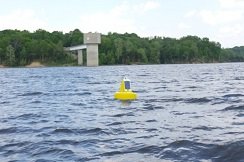Harmful Algal Blooms Monitoring and Remote Sensing Research

It can be difficult to know when and where Harmful Algal Blooms (HABs) will form. Although understanding of HABs characterization and assessment has improved greatly, it can be costly to provide guidance or apply prevention and management strategies. EPA’s HABs monitoring research employs basic ecological knowledge of how environmental drivers impact the development of biomass and the occurrence of toxins. Data sources range from fundamental research to high-frequency modern sensors, and from local sampling to satellite imagery. The results of this work can be used to characterize the development, intensity, and spatial extent of HABs in rivers, streams, lakes, and reservoirs, including recreational and source water.
EPA’s HABs monitoring research includes the following:
- Cyanobacteria Assessment Network mobile application (CyAN app) improvements to quickly inform decisions regarding recreational and drinking water safety related to cyanobacterial blooms.
- Development of methods for early detection of algal toxin production using qPCR.
- Machine learning models combined with genomic and environmental drivers to predict toxins and biomass.
- Remote sensing using satellites to help water managers predict future high-risk cyanobacterial harmful algal blooms.
Related Research
- Cyanobacteria Assessment Network (CyAN) Project
- Harmful Algal Blooms and Cyanobacteria Research
- Harmful Algal Blooms Mitigation and Treatment Research
- Epidemiology and Health Effects of Cyanobacteria Research
- Data Mining and Harmful Algal Blooms
- Modeling the Links Between Discharge and Nutrients from the Mississippi River Basin to the Gulf of America Hypoxia
Research Publications and Presentations
- HABs monitoring publications in Science Inventory
- Remote sensing publications in Science Inventory
- Publication Highlights
- Forecasting freshwater cyanobacterial harmful algal blooms for Sentinel-3 satellite resolved U.S. lakes and reservoirs (January 2024)
- Assessing potential of the Geostationary Littoral Imaging and Monitoring Radiometer (GLIMR) for water quality monitoring across the coastal United States (November 2023)
- Assessing the suitability of lakes and reservoirs for recreation using Landsat 8 (October 2023)
- Identifying lakes at risk of toxic cyanobacterial blooms using satellite imagery and field surveys across the United States (April 2023)
- Cyanotoxin-encoding genes as powerful predictors of cyanotoxin production during harmful cyanobacterial blooms in an inland freshwater lake: Evaluating a novel early-warning system (July 2022)
- Satellites quantify the spatial extent of cyanobacterial blooms across the United States at multiple scales (July 2022)
- A validation of satellite derived cyanobacteria detections with state reported events and recreation advisories across U.S. lakes (June 2022)
- Satellites for long-term monitoring of inland U.S. lakes: The MERIS time series and application for chlorophyll-a (December 2021)
- Predictive Model of Lake Photic Zone Temperature Across the Conterminous United States. Frontiers in Environmental Science (October 2021). GitHub
- Satellite remote sensing to assess cyanobacterial bloom frequency across the United States at multiple spatial scales (September 2021)
- Quantifying national and regional cyanobacterial occurrence in US lakes using satellite remote sensing (April 2020)
- Use of qPCR and RT-qPCR for monitoring variations of microcystin producers and as an early warning system to predict toxin production in an Ohio inland lake (March 2020)
- Measurement of Cyanobacterial Bloom Magnitude using Satellite Remote Sensing (December 2019)
- Presentation Highlights
- Water Research Webinar - Real-Time Risk Characterization Tool for Harmful Algae Blooms: Ohio River (Webinar, November 2022)
- CyAN App: Cyanobacteria Assessment Network Mobile Application (Presentation, July 2019)
- Multi-Source Remote Sensing for Assessment and Management of Surface Waters (Presentation, May 2019)
- Datasets
- Provisional Harmful Algal Bloom Data for Mashapaug Pond (Providence, Rhode Island) and Lake Archer (Wrentham, Massachusetts): This GitHub repository houses provisional water quality monitoring datasets collected from two water bodies: Mashapaug Pond in Providence, Rhode Island and Lake Archer in Wrentham, Massachusetts. These data are collected to help track, understand and eventually forecast potential HABs. EPA makes the data available so that others interested in water quality and HABs – such as water resource managers, other researchers, and interested community members – can have access to current information. EPA has previously partnered with the Town of Barnstable, Massachusetts to collect similar data for Shubael and Hamblin Ponds, also available in this GitHub repository.
